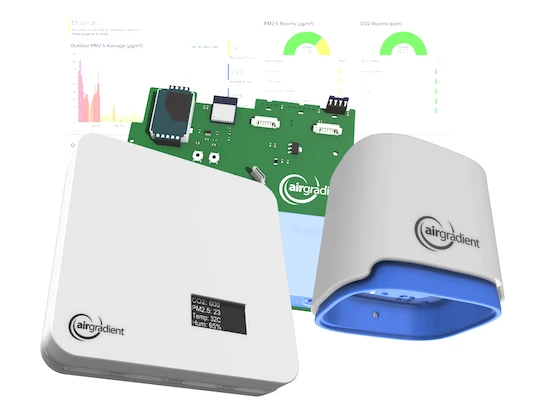Open and Accurate Air Quality Monitors
We design professional, accurate and long-lasting air quality monitors that are open-source and open-hardware so that you have full control on how you want to use the monitor.
Learn Moreby Achim Haug on September 24, 2023
A few weeks ago, I wrote quite a popular blog post titled “Air Quality Monitors: When Paying More Does Not Get You More Accuracy” with the key takeaway that the accuracy of PM2.5 does not get better the more expensive the monitor is. One of the things that this post did not dive in was WHY the accuracy is very similar across all these monitors.
So I thought why not take a closer look at what type of PM sensor modules these monitors use, and so I went through the South Coast AQMD list of their tested air quality monitors as they state in their field report the PM module used. I looked up the most popular brands across a large price range and this is what I found:
From the monitors I looked at, all except one, use low-cost PM modules costing between USD 10 - 20 in bulk quantities. The notable exception is the QuantQM that uses a more expensive AlphaSense OPC-N3 optical particle counter (in addition to the Plantower PMS5003).
I also added our own open-hardware air quality monitor Open Air as comparison into the table, and I am happy to see that it is very affordably priced for the sensors it offers.
It is interesting to see that even much more expensive monitors use very low-cost PM sensor modules, and it’s difficult to give a clear reason, but I think mainly two factors come into play:
Low-cost PM modules have quite a good performance for measuring PM1 and PM2.5 and with adjusted compensation algorithms that take into account impacts of humidity or specific particle concentrations, these low-cost sensors can be tuned to be very close to reference station accuracy. So in this respect, these sensor modules are “good enough” for a variety of purposes. What’s sometimes lacking -but this is for another post- is that most manufacturers don’t publicise their compensation algorithms so it’s not clear what corrections are made and how these correction factors have been derived. Where all of these low-cost sensors underperform is with larger particle sizes like PM10 but since the main focus is on PM1 and PM2.5 (as these are more harmful for the body), often PM10 is not such an important criteria.
As you can see from the table, there are 3-4 manufacturers in the USD 10-20 range, Plantower being the most popular one. Then on the other side of the spectrum you have reference grade sensors (like BAMs, GRIMMs, Palas) in the price range above USD 20.000. In between these two extremes is very little choice. There are a few in the price range USD 50-100 that deliver pretty much the same accuracy as the cheaper ones and don’t offer advantages. Above USD 100, the AlphaSense OPC-N3 is a good addition, especially as its performance for PM10 is much better. Then there are sensors that use special filter material that needs to be changed and maintained which is not ideal if the system should be low-maintenance.
It’s important to point out that not only the PM sensor module determines the accuracy of the whole monitor but there are other factors that can have a significant impact on the quality of the measurements. Here are a few:
In case you are considering getting an air quality monitor, I would recommend the following:
Please share your thoughts with us and let us know what kind of topics you would like us to write about.
Disclaimer: This article contains information about our own products. Read more about how we are trying to stay transparent.
Curious about upcoming webinars, company updates, and the latest air quality trends? Sign up for our weekly newsletter and get the inside scoop delivered straight to your inbox.
Join our Newsletter
We design professional, accurate and long-lasting air quality monitors that are open-source and open-hardware so that you have full control on how you want to use the monitor.
Learn More